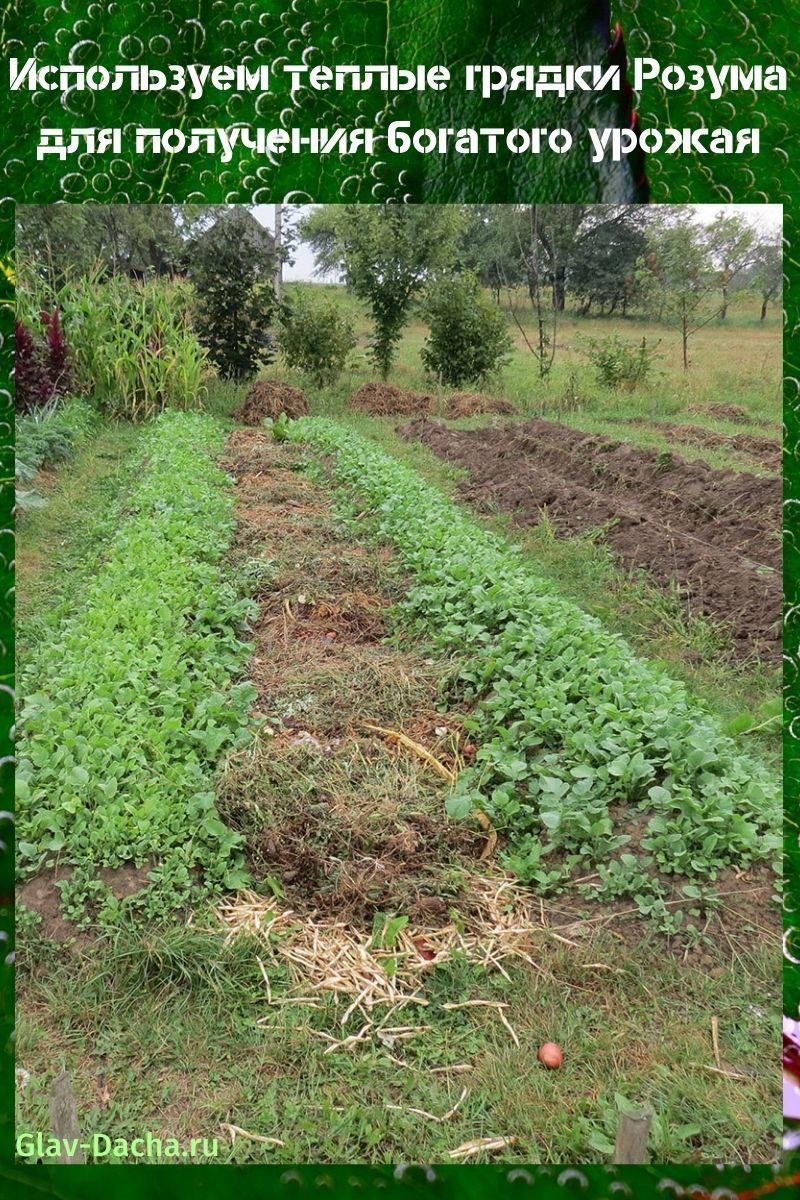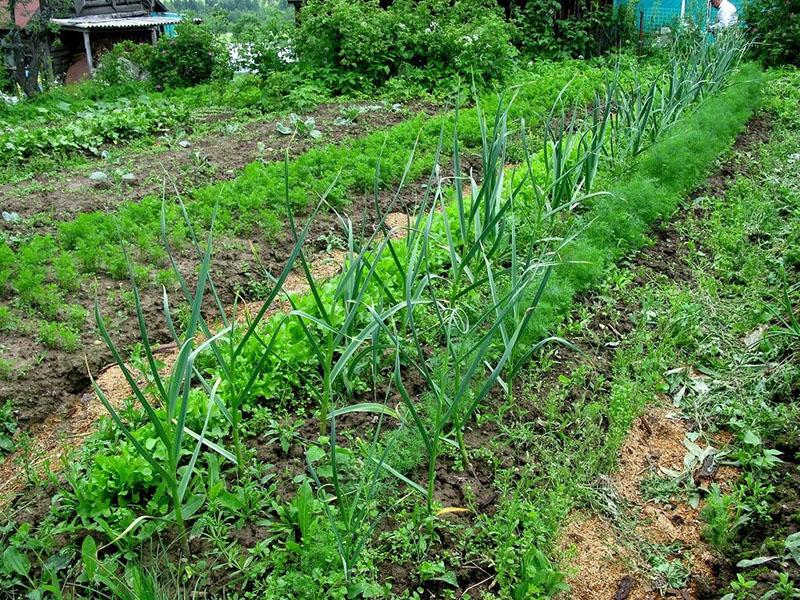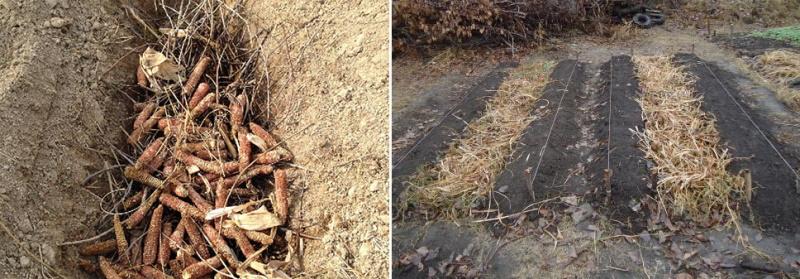We use the warm beds of Rozum for a rich harvest
 The warm beds of Rozuma are a vegetable growing technology related to organic farming. It provides an opportunity to use abandoned infertile areas, increase soil productivity and reduce labor costs for processing the territory.
The warm beds of Rozuma are a vegetable growing technology related to organic farming. It provides an opportunity to use abandoned infertile areas, increase soil productivity and reduce labor costs for processing the territory.
Reasons for the demand for warm beds of Rozum

The main goal of the warm beds of Rozum was the effective and efficient processing of abandoned and infertile areas, where only weeds germinated for a long time, increasing productivity and minimizing labor costs.
What are the warm beds of Rosum used for?:
- Cultivation of barren, abandoned, deserted areas covered with weeds. Thanks to a specially developed technology, the natural resources of the soil are fully renewed in just two seasons.
- Cultivation of virgin lands or lands that have not been cultivated for a long time. This method is great for "digging" sod, poor, rocky soils. The warm beds of Rosum saturate the soil with nutrients and improve its fertile qualities.
- Increased productivity. Most of all, the warm beds of Rosum are suitable for growing cucumbers, tomatoes, bell pepper and berry crops, increasing their yield by 40-60%.
- Minimum labor costs - they are required only once, when arranging warm beds.
- Environmental friendliness - vegetable crops are grown in warm beds exclusively with the help of organic matter, without the use of industrial fertilizers. This allows you to collect a rich natural and environmentally friendly harvest.
Warm beds of Vladimir Rozum can be created on any soil, regardless of its type and quality, as well as at any time of the year, both in early spring and before the first winter frosts.
Warm beds of Rozuma - the main advantages
 The design of the warm Rozuma beds consists of 30 cm wide planting ridges and an organic trench located between them.
The design of the warm Rozuma beds consists of 30 cm wide planting ridges and an organic trench located between them.
They have several significant differences and advantages over conventional beds:
- Vegetable crops are grown on the ground without the introduction of organic matter. Due to this, there are no fungal microorganisms and decay processes in the soil, it is excellent for growing almost all vegetable crops, including tuberous ones.
- The trench between the beds, filled with organic matter, provides adequate nutrition for all plants for several years.
- When grown in warm beds, the plants do not need frequent watering, as they can receive all the necessary moisture from the trench.
- Due to the abundance of moisture and nutrients, Rozuma beds are excellent for combined and compacted plantings.
- When the trench is completely filled with organic substances, its width increases to 50-70 cm. Such a path does not require additional arrangement.
- A dense layer of organic matter, when overheated, releases a significant amount of heat, providing a comfortable growing of plants in regions with a cold climate.
 Planting and maintaining the intensive beds of Rozuma does not require the maintenance of separate compost heaps - instead, trenches filled with organic matter are used. This saves space on a small garden plot, as well as the time required to work with compost.
Planting and maintaining the intensive beds of Rozuma does not require the maintenance of separate compost heaps - instead, trenches filled with organic matter are used. This saves space on a small garden plot, as well as the time required to work with compost. 
The average "age" of the intensive beds of Rozum is 5-7 years. At the same time, the only thing that is required to maintain a high level of their fertility is the annual addition of an organic layer.
After 6-7 years, the beds must be completely renewed, since after about this time, the lower layer of the branches completely rotted and loses its functions, reducing the fertility of the site.
Rozum warm beds scheme
 Before making the beds of Rozum, you need to mark them out. The marking is carried out only in the area, previously cleared of weeds and debris and fluffed to a depth of 10-15 cm. The optimal length of a warm bed is 1.2-1.4 m.
Before making the beds of Rozum, you need to mark them out. The marking is carried out only in the area, previously cleared of weeds and debris and fluffed to a depth of 10-15 cm. The optimal length of a warm bed is 1.2-1.4 m.
Rozum's bed scheme:
- the width of the central strip filled with organic matter is 55-65 cm;
- on both sides of the trench, there are forage beds, the width of which should not exceed 35-40 cm;
- leave space for paths on both sides of the feed beds - their maximum width is 50-60 cm.
After making measurements, preparing the site and marking it, you can proceed to the direct arrangement of the warm beds of Rozum.
How to make warm beds
 Rozuma's beds in the greenhouse and on open soil are made using a similar technology. In the central part of the prepared area, a trench is made for organic matter - most often it is wedge-shaped with a strong narrowing downward, up to 30 cm deep.This depression is most conveniently done with a regular hoe or with the help of Fokin's plane cutter.
Rozuma's beds in the greenhouse and on open soil are made using a similar technology. In the central part of the prepared area, a trench is made for organic matter - most often it is wedge-shaped with a strong narrowing downward, up to 30 cm deep.This depression is most conveniently done with a regular hoe or with the help of Fokin's plane cutter.
Fold the soil obtained when digging a trench on the sides of it. This will help raise the height of the beds. The sides of the groove should be cut at an angle and a slight cut should be made to prevent soil from falling into the trench and help preserve the structure for several years.
Step-by-step preparation of warm beds:
- Fill a layer of large branches at the bottom of the formed trench. Solid wood beams or planks can be used instead. The height of such a layer, which ensures effective air circulation and self-sufficiency of the system with moisture, is 10-15 cm.

- Pour small branches evenly over them. The bottom of the trench is best lined with a metal mesh with fine meshes - this will prevent the appearance of rodents in the layer of branches.
- Pour a layer of organic matter on top of small branches and tamp well. For this purpose, you can use hay, chopped grass, fallen leaves, manure, food waste.

- Pour the organic layer with any EM-preparation - Emochka, Baikal, Radiance. This will speed up the multiplication of beneficial microorganisms.

- At the final stage, be sure to mulch the trench with organic matter. To do this, sprinkle the central ditch with hay, humus, pine needles or sawdust. The mulch layer should be at least 8-10 cm.
A layer of mulch provides a "greenhouse effect" for organic matter and accelerates the decomposition process. This increases the yield of plants.
The principle of operation of warm beds of Rozum
 Improving yields on poor, stony soils is achieved through the correct placement and design of warm beds. Their lower layer consists of large branches that provide good air microcirculation.
Improving yields on poor, stony soils is achieved through the correct placement and design of warm beds. Their lower layer consists of large branches that provide good air microcirculation.
The temperature of the deep layers of the soil is much lower than the upper ones. In combination with air microcirculation, this creates moisture condensation - it replenishes the moisture need not only of plants, but also of the soil. That is why there is no need for watering when growing vegetables in the warm beds of Rozum.
The shallow organic layer is an excellent food for green spaces. In the process of decomposition, it releases not only useful nutrients, but also carbon dioxide, which plants require for their growth and development.
Planting rules
 The basic rule when growing crops in the warm beds of Rozum is that they are planted exclusively in the forage beds. Plants should not be sown in the central part of the plot, as this will cause a rapid decrease in the fertility of the beds.
The basic rule when growing crops in the warm beds of Rozum is that they are planted exclusively in the forage beds. Plants should not be sown in the central part of the plot, as this will cause a rapid decrease in the fertility of the beds.
In the first 1-2 years after the creation of intensive Rozum beds, the best option is to plant vegetable crops that require regular hilling. This will help deepen the groove and maximize its fertility.
In the third year after arranging the beds, other vegetable crops can be grown:
- tomatoes;
- cucumbers;
- white cabbage;
- zucchini;
- pumpkin;
- peas;
- various greens.
The warm beds of Rozuma are one of the most famous and demanded technologies of organic farming. With its help, you can "develop" deserted, abandoned areas. To increase the productivity of vegetable crops and the fertility of poor, rocky soil. The original design of the Rozuma beds allows you to get the maximum yield with a minimum of physical effort and on any type of soil.